Thank you for that. As you noticed, in most cases, the bond was good enough that a layer of the strips was left behind, indicating I think that the strip wood was weaker than the pear to which it was attached. Where that wasn't the case, it was probably that the glue bond was not as good to the pear wood, and the glue joint failed. But I was pleased that a reasonable bond occurred under just about all conditions. Certainly strong enough for planking.A test that was very well done, well executed with a spreadsheet easy to follow - thank you. Now, one thing I noticed is this. I noticed that some of the glued parts that broke off the test left a "skin" of the piece broken off. Whereas some other pieces made a "clean break" from the other piece of wood. That tells me that the ones that had the other woods "skin" left on the testing piece was really bonding so tight that it left a remaining skin behind.
I am not sure if I am explaining myself well enough.
-

Win a Free Custom Engraved Brass Coin!!!
As a way to introduce our brass coins to the community, we will raffle off a free coin during the month of August. Follow link ABOVE for instructions for entering.
You are using an out of date browser. It may not display this or other websites correctly.
You should upgrade or use an alternative browser.
You should upgrade or use an alternative browser.
Awesome information…thanks! This also confirms my experience with using matte sheen rub-on polyurethane as a parts finish and wood sealer as I build. I have not had any problem with glue adhesion between poly coated parts or gluing to poly coated parts with either PVA and CA glues. This is just an accidental anecdotal affirmation of the test.
I thought I would do an updated test. I am beginning the build of a 1/20 scale 32-pound gun from the Victory. My son made a 3D model of the barrel, which I drew using Fusion 360, as well as a carriage. But I'm not happy with the finish on the carriage, and have decided to make it of cherry instead. The brackets were originally made in 2 pieces, bolted together, and I will be edge gluing them together first. I want to use a strong glue for this, to be sure it stays together, and with 8+ glues sitting in front of my, I thought I'd do a test of them first.
For pieces to test, I used the 5 x 10 x 120 mm railroad ties included with the Occre Large Locomotive Stand. There were 17 included in the kit, so that gave me 8 pairs to test. (I hadn't used these pieces, as I wanted to have more and nicer ties, so made 28 of my own of cherry wood). These are a white fine-grained wood, softwood I think, but am not sure.
I planned to overlap the pieces by 1", giving a reasonably large gluing are, so marked one piece accordingly:
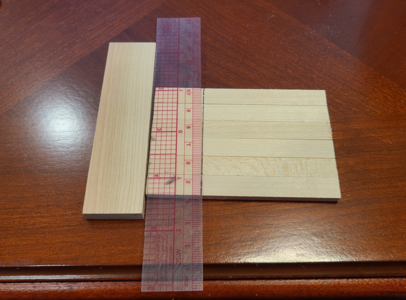
I glued each pair together with the 1" overlap, and marked one side with what glue was used:
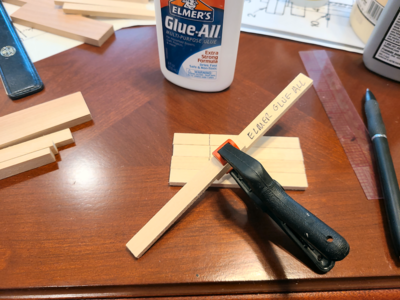
I chose these glues for the test (mostly because I had them on hand and have used them all in the past):
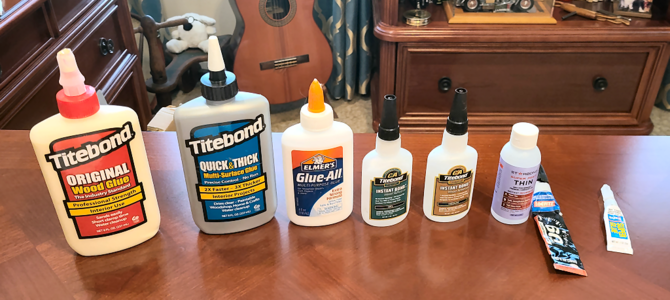
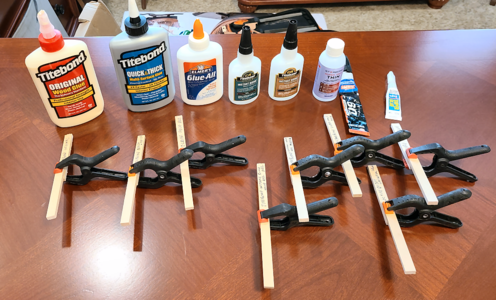
I then made a jig to hold the pieces in a consistent manner of scrap on hand:
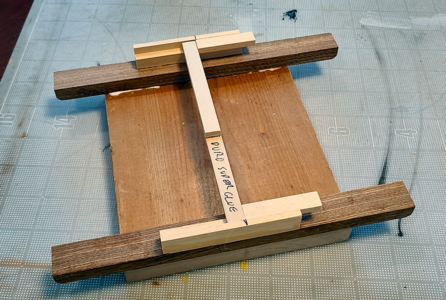
I then placed the jig into a plastic box I have attached to a 16kg capacity scale that measures quite accurately.
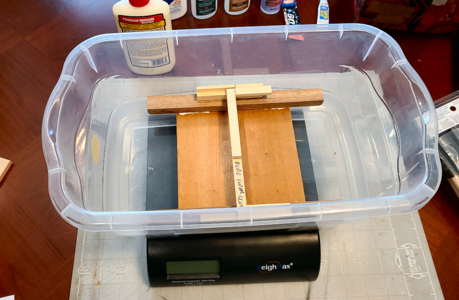
I use this scale to weigh our cats occasionally (thus the containing box) as well as other items.
The scale arrangement is then like this:
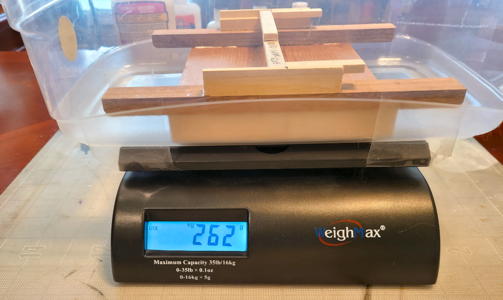
From my previous testing, I knew it would be difficult to determine what the exact reading was at the moment of failure, so decided to take a video of each test. This is the arrangement I ended up with that could read the scale reading best: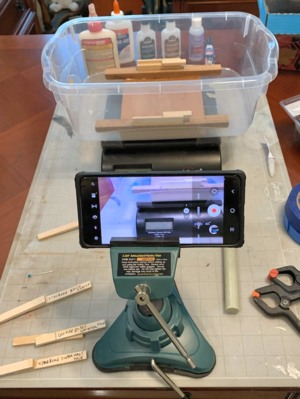
I found it difficult to press hard enough with my thumb or knuckle, so ended up using a round plastic rod I had on hand, held in both hands, and pressing slowly:
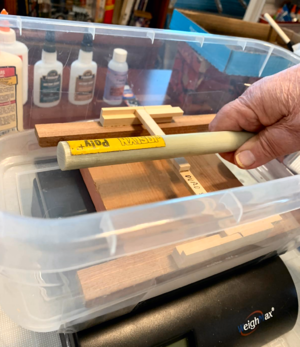
I typical recorded test went like this:
View attachment Titebond Instant Gel_Trim.mp4
(This video had to be trimmed in length to be able to upload)
I then scanned each video, frame by frame, to determine the maximum force in kilograms that it took to break each sample. These are tabulated in the table below:
I've left a column in the above table for strength readings after a second gluing and testing, using a different portion of each stick which has been coated once with Minwax Wipe-On Poly Clear Stain polyurethane varnish. Many times I have to coat a piece with at least a coat of clear before gluing it in place, as portions are later inaccessible otherwise.
Concerning the results, the Starbond Super Fast Thin super glue soaked into the wood so fast, and only one piece was coated, so maybe that didn't quite have the chance the others did. If used for it this purpose, I should probably coat both pieces and connect them quickly.
One surprise to me was the Walmart special Elmer Glue-All Multipurpose Glue. Cheap, in an easy-to-direct small-nozzle container, I didn't expect it to do so well, yet it did better than Titebond Original. Also surprising, Titebond Quick & Thick scored highest, even higher than Original Titebond, which I did not expect. And it's good to know that the cheapest of super glues, Duro, is still pretty good.
Some error definitely occurred within the wood itself, some pieces being stronger than others. For example, some ripped out the wood itself, while most failed at the glue joint, but I think that mostly means I'm in the right ballpark, force-wise, for this test and samples. So, I think the above results are representative. Mostly they show that for ship-building purposes, pretty much any of these glues will do the job to hold a plank to a frame, and it's mostly a user preference or will depend on how quickly you need the joint to cure and how much movement you want to allow.
I hope this is of some interest and assistance to people who read it. I will follow up this article once I do tests on the varnished pieces to give a more complete picture of the capabilities of the various glues tested.
For pieces to test, I used the 5 x 10 x 120 mm railroad ties included with the Occre Large Locomotive Stand. There were 17 included in the kit, so that gave me 8 pairs to test. (I hadn't used these pieces, as I wanted to have more and nicer ties, so made 28 of my own of cherry wood). These are a white fine-grained wood, softwood I think, but am not sure.
I planned to overlap the pieces by 1", giving a reasonably large gluing are, so marked one piece accordingly:

I glued each pair together with the 1" overlap, and marked one side with what glue was used:

I chose these glues for the test (mostly because I had them on hand and have used them all in the past):

- Titebond Original Wood Glue is probably the most popular glue, PVA, not waterproof but considered very strong.
- Titebond Quick & Thick Multi-Surface Glue is a thicker version that doesn't drip and cures more quickly. I've had good success with it in modeling.
- Elmer's Glue-All Multi-Purpose Glue I've always considered more of a "School Glue", and didn't expect much strength, but was surprised.
- Titebond Instant Bond Wood Adhesive - Medium is a relatively new super glue, designed for porous wood rather than non-wood smooth surfaces.
- Titebond Instant Bond Wood Adhesive - Gel is a thicker version of the Medium above. They also make a Thin version.
- Starbond Super Fast Thin is a very thin super glue not really designed for wood, but I thought I'd try it as it seeps into narrow gaps quite well.
- Loctite/Heinkel 60 Sec. Universal Glue is a super glue with a thickener, which tacks things together initially, but allows movement for 20 seconds or so, then hardens quickly like super glue.
- Duro Super Glue came in a pack of 6 or 8, cheap at Walmart, so I wanted to see how it stacked up as well.

I then made a jig to hold the pieces in a consistent manner of scrap on hand:

I then placed the jig into a plastic box I have attached to a 16kg capacity scale that measures quite accurately.

I use this scale to weigh our cats occasionally (thus the containing box) as well as other items.
The scale arrangement is then like this:

From my previous testing, I knew it would be difficult to determine what the exact reading was at the moment of failure, so decided to take a video of each test. This is the arrangement I ended up with that could read the scale reading best:

I found it difficult to press hard enough with my thumb or knuckle, so ended up using a round plastic rod I had on hand, held in both hands, and pressing slowly:

I typical recorded test went like this:
View attachment Titebond Instant Gel_Trim.mp4
(This video had to be trimmed in length to be able to upload)
I then scanned each video, frame by frame, to determine the maximum force in kilograms that it took to break each sample. These are tabulated in the table below:
| Glue Description | Force in kg, Dry | Force in kg, Varnished |
| Titebond Original Wood Glue | 7.45 | Error in test |
| Titebond Quick & Thick Multi-Surface Glue | 11.94 | 4.91 |
| Elmer's Glue-All Multi-Purpose Glue | 9.69 | 3.48 |
| Titebond Instant Bond Wood Adhesive - Medium | 7.34 | 7.48 |
| Titebond Instant Bond Wood Adhesive - Gel | 5.90 | 6.86 |
| Starbond Super Fast Thin | 3.35 | 9.45 |
| Loctite/Heinkel 60 Sec. Universal Glue | 4.96 | 5.00 |
| Duro Super Glue | 4.90 | 6.95 |
Concerning the results, the Starbond Super Fast Thin super glue soaked into the wood so fast, and only one piece was coated, so maybe that didn't quite have the chance the others did. If used for it this purpose, I should probably coat both pieces and connect them quickly.
One surprise to me was the Walmart special Elmer Glue-All Multipurpose Glue. Cheap, in an easy-to-direct small-nozzle container, I didn't expect it to do so well, yet it did better than Titebond Original. Also surprising, Titebond Quick & Thick scored highest, even higher than Original Titebond, which I did not expect. And it's good to know that the cheapest of super glues, Duro, is still pretty good.
Some error definitely occurred within the wood itself, some pieces being stronger than others. For example, some ripped out the wood itself, while most failed at the glue joint, but I think that mostly means I'm in the right ballpark, force-wise, for this test and samples. So, I think the above results are representative. Mostly they show that for ship-building purposes, pretty much any of these glues will do the job to hold a plank to a frame, and it's mostly a user preference or will depend on how quickly you need the joint to cure and how much movement you want to allow.
I hope this is of some interest and assistance to people who read it. I will follow up this article once I do tests on the varnished pieces to give a more complete picture of the capabilities of the various glues tested.
Last edited:
I updated the above table for tests done on a sealed surface. Note that this is a thin coat of rub-on varnish, which soaks into this relatively soft wood, and not a real test of a smooth, varnished finish. I would expect white glues to do worse and super glues better on a smooth, varnished surface.
I screwed up the Titebond Original test; sorry. Notable in the test: the Starbond Super Fast Thin was the strongest when sufficient was applied on a sealed surface. In general, the PVA glues lost half their strength or more, while the super glues held or gained strength, on sealed surfaces. That makes sense.
I guess this is the completion of my glue testing. Not a lot discovered, other than most glues work, reasonably well, when building ship models.
I screwed up the Titebond Original test; sorry. Notable in the test: the Starbond Super Fast Thin was the strongest when sufficient was applied on a sealed surface. In general, the PVA glues lost half their strength or more, while the super glues held or gained strength, on sealed surfaces. That makes sense.
I guess this is the completion of my glue testing. Not a lot discovered, other than most glues work, reasonably well, when building ship models.
Fantastic tests. Well done.I thought I would do an updated test. I am beginning the build of a 1/20 scale 32-pound gun from the Victory. My son made a 3D model of the barrel, which I drew using Fusion 360, as well as a carriage. But I'm not happy with the finish on the carriage, and have decided to make it of cherry instead. The brackets were originally made in 2 pieces, bolted together, and I will be edge gluing them together first. I want to use a strong glue for this, to be sure it stays together, and with 8+ glues sitting in front of my, I thought I'd do a test of them first.
For pieces to test, I used the 5 x 10 x 120 mm railroad ties included with the Occre Large Locomotive Stand. There were 17 included in the kit, so that gave me 8 pairs to test. (I hadn't used these pieces, as I wanted to have more and nicer ties, so made 28 of my own of cherry wood). These are a white fine-grained wood, softwood I think, but am not sure.
I planned to overlap the pieces by 1", giving a reasonably large gluing are, so marked one piece accordingly:
View attachment 334679
I glued each pair together with the 1" overlap, and marked one side with what glue was used:
View attachment 334681
I chose these glues for the test (mostly because I had them on hand and have used them all in the past):
View attachment 334683
All of the glues along with their glued samples:
- Titebond Original Wood Glue is probably the most popular glue, PVA, not waterproof but considered very strong.
- Titebond Quick & Thick Multi-Surface Glue is a thicker version that doesn't drip and cures more quickly. I've had good success with it in modeling.
- Elmer's Glue-All Multi-Purpose Glue I've always considered more of a "School Glue", and didn't expect much strength, but was surprised.
- Titebond Instant Bond Wood Adhesive - Medium is a relatively new super glue, designed for porous wood rather than non-wood smooth surfaces.
- Titebond Instant Bond Wood Adhesive - Gel is a thicker version of the Medium above. They also make a Thin version.
- Starbond Super Fast Thin is a very thin super glue not really designed for wood, but I thought I'd try it as it seeps into narrow gaps quite well.
- Loctite/Heinkel 60 Sec. Universal Glue is a super glue with a thickener, which tacks things together initially, but allows movement for 20 seconds or so, then hardens quickly like super glue.
- Duro Super Glue came in a pack of 6 or 8, cheap at Walmart, so I wanted to see how it stacked up as well.
View attachment 334684
I then made a jig to hold the pieces in a consistent manner of scrap on hand:
View attachment 334685
I then placed the jig into a plastic box I have attached to a 16kg capacity scale that measures quite accurately.
View attachment 334686
I use this scale to weigh our cats occasionally (thus the containing box) as well as other items.
The scale arrangement is then like this:
View attachment 334687
From my previous testing, I knew it would be difficult to determine what the exact reading was at the moment of failure, so decided to take a video of each test. This is the arrangement I ended up with that could read the scale reading best:View attachment 334688
I found it difficult to press hard enough with my thumb or knuckle, so ended up using a round plastic rod I had on hand, held in both hands, and pressing slowly:
View attachment 334689
I typical recorded test went like this:
View attachment 334690
(This video had to be trimmed in length to be able to upload)
I then scanned each video, frame by frame, to determine the maximum force in kilograms that it took to break each sample. These are tabulated in the table below:
I've left a column in the above table for strength readings after a second gluing and testing, using a different portion of each stick which has been coated once with Minwax Wipe-On Poly Clear Stain polyurethane varnish. Many times I have to coat a piece with at least a coat of clear before gluing it in place, as portions are later inaccessible otherwise.
Glue Description Force in kg, Dry Force in kg, Varnished Titebond Original Wood Glue 7.45 Error in test Titebond Quick & Thick Multi-Surface Glue 11.94 4.91 Elmer's Glue-All Multi-Purpose Glue 9.69 3.48 Titebond Instant Bond Wood Adhesive - Medium 7.34 7.48 Titebond Instant Bond Wood Adhesive - Gel 5.90 6.86 Starbond Super Fast Thin 3.35 9.45 Loctite/Heinkel 60 Sec. Universal Glue 4.96 5.00 Duro Super Glue 4.90 6.95
Concerning the results, the Starbond Super Fast Thin super glue soaked into the wood so fast, and only one piece was coated, so maybe that didn't quite have the chance the others did. If used for it this purpose, I should probably coat both pieces and connect them quickly.
One surprise to me was the Walmart special Elmer Glue-All Multipurpose Glue. Cheap, in an easy-to-direct small-nozzle container, I didn't expect it to do so well, yet it did better than Titebond Original. Also surprising, Titebond Quick & Thick scored highest, even higher than Original Titebond, which I did not expect. And it's good to know that the cheapest of super glues, Duro, is still pretty good.
Some error definitely occurred within the wood itself, some pieces being stronger than others. For example, some ripped out the wood itself, while most failed at the glue joint, but I think that mostly means I'm in the right ballpark, force-wise, for this test and samples. So, I think the above results are representative. Mostly they show that for ship-building purposes, pretty much any of these glues will do the job to hold a plank to a frame, and it's mostly a user preference or will depend on how quickly you need the joint to cure and how much movement you want to allow.
I hope this is of some interest and assistance to people who read it. I will follow up this article once I do tests on the varnished pieces to give a more complete picture of the capabilities of the various glues tested.
Just a note about the wood tearing.
I mostly use Selleys Aquadhere Interior, a high quality interior PVA wood glue. "It goes on white but dries clear, so is perfect for woodwork and craft as it won't stain timber surfaces". Once cured most joints will tear the wood before the glue gives way. This is an Australian product with limited overseas reach.
Thank you very much!Fantastic tests. Well done.
Just a note about the wood tearing.
I mostly use Selleys Aquadhere Interior, a high quality interior PVA wood glue. "It goes on white but dries clear, so is perfect for woodwork and craft as it won't stain timber surfaces". Once cured most joints will tear the wood before the glue gives way. This is an Australian product with limited overseas reach.
You're right. Very limited availability in the States. A concern of mine would be their statement that "Do not use on projects that need to be sanded, as Aquadhere Interior is not sandable". Although if cleaned well, it may not need sanding, but I think I'd like to be able to do so.
Hi SignetYou're right. Very limited availability in the States. A concern of mine would be their statement that "Do not use on projects that need to be sanded, as Aquadhere Interior is not sandable". Although if cleaned well, it may not need sanding, but I think I'd like to be able to do so.
That's what it says, but I sand small areas all the time and it is fine. It has to be well cured to be sure.
The trick is to wipe off any excess with a damp cloth as you work and any small areas which escape that can be removed with sandpaper.


